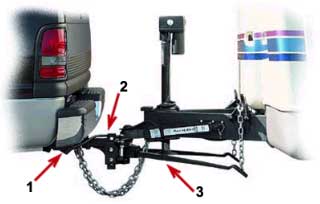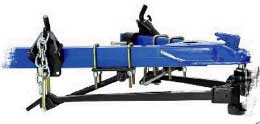| |
|
About Weight Distributing Hitch Systems
|
|
A weight-distributing system applies leverage for heavier loads, 350
lbs. tongue weight or higher, to distribute trailer tongue weight to all
tow vehicle and trailer wheels. It offers a more level ride, greater
steering and brake control and enhances towing safety. The addition of a
friction sway control also dampens sway caused by traffic and crosswinds
and contributes positively to tow vehicle and trailer stability.
|
|
|
|

|
A Reese
Weight-Distributing system is composed of four major elements:
1. the hitch receiver.
2. the ball mount
3. the spring bar assembly and,
4. the sway control (see below)
These components work in unison to provide complete towing system
compatibility. |
|
Operation of a Weight-Distributing Hitch
The Reese differences are in construction materials, welding,
manufacturing processes and hook-up. Adjustment is simple because
of the easy-to-operate snap-up brackets that allow spring bar tension to
be adjusted by changing links in the support chains. This lets you
adjust for various trailer tongue weights within the spring bar weight
range by applying tension on the spring bars until the car or tow
vehicle is level. Rather than merely supporting the trailer tongue
weight (TW), weight distributing hitches apply leverage between the
towing vehicle and trailer causing the TW to be carried by all axles of
the tow vehicle and trailer. When TW is distributed in this way,
trailers with greater TWs can be towed resulting in a more level ride
which reduces stress on the rear of the tow vehicle and provides greater
steering and brake control.
|
|
|
|
Trailer
Sway
This must always be considered in trailer towing. Unwanted
sway turns a pleasant towing situation sour. Many factors can
contribute to trailer sway - the design of the trailer, the suspension,
tire inflation pressures, configuration of the tow vehicle, towing
speeds and hitch weight. Therefore, Draw Tite has devised several
options to resist or temper trailer sway.
|
|
|
|
Sway
Control
There are two popular methods of sway control. The older more
common form of sway control is a friction device referred to as Friction
Sway Control.
A more contemporary approach is a device controlled by cam action.
Know as Dual Cam Sway Control, it is an innovative and effective
technique to help control trailer sway before it starts.
|
|
More
About Friction Sway Control
The Friction Sway Control does exactly what its name implies, it
uses friction to resist pivotal movement and thereby works against the
effects of induced sway. It operates on the principle of
"stiffening" the coupling between the tow vehicle and trailer.
The degree of "stiffening" or friction is adjusted to suit
various trailer weights and towing conditions. Its operation is simple
and uncomplicated. It doesn't prevent the generation of sway, it
simply works to resist the forces once they have started.
|
|
 More
About Dual Cam Sway Control More
About Dual Cam Sway Control
This patented product is the premier method for controlling trailer sway.
Unlike the friction sway control, this approach works to control sway
from the start rather than just resisting sway once it's begun.
And it works only when needed. When towing in a straight line, the cams
on either side of the trailer A-frame are locked in position. This
essentially creates a "rigid" connection between tow vehicle
and trailer and minimizes the effects of induced sway caused by high
cross-winds or passing vehicles. Usually the cams ride in a
detent, locked in position, even on fairly sharp curves. However,
cornering maneuvers are required, the cams automatically slide out of
their detent to permit full radius turns. Yet when the maneuver is
short and abrupt, like that encountered in the event of a sudden swerve
or a wheel dropping off the road, the cams seek a straight line towing
angle that helps the tow vehicle retain control. The advantage
of the dual cam system is its ability to forestall sway in addition to
sway resistance. It works to hold down the start of swaying
activity while at the same time allowing free and easy vehicle and
trailer interaction. Another advantage of the dual cam system is
that it's installed on the trailer and therefore doesn't require
adjustment every time the towing vehicle and trailer are hooked up,
unless hitch weight or tow vehicle loading are changed.
|